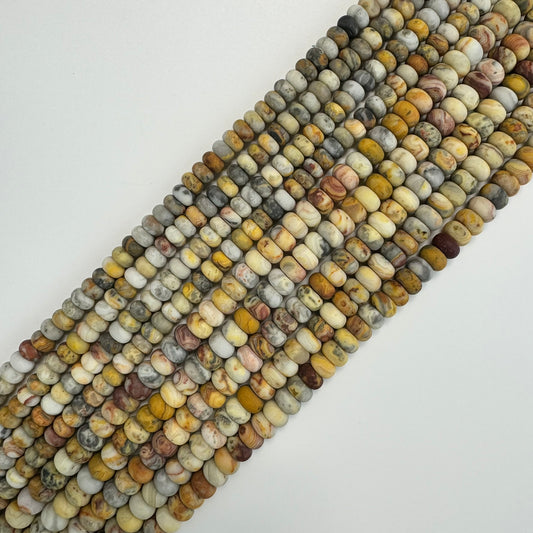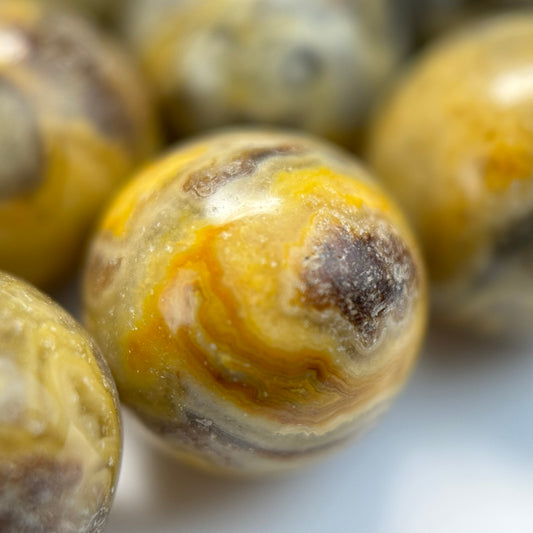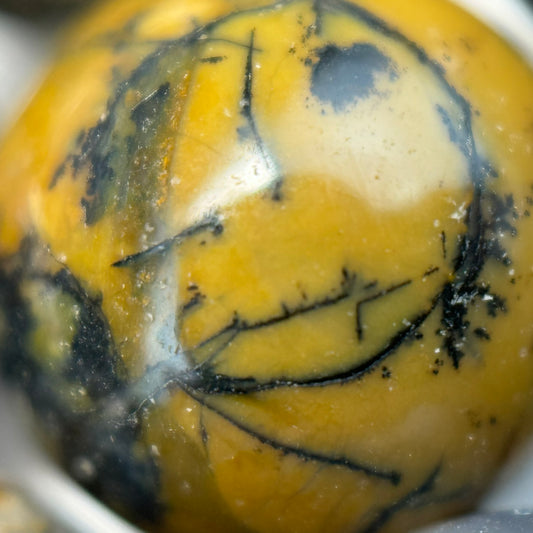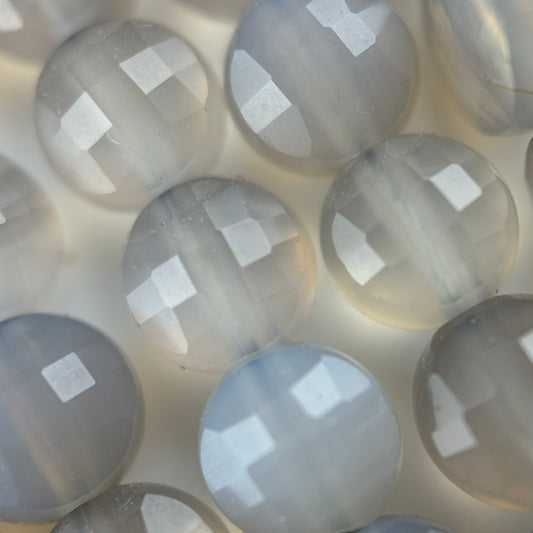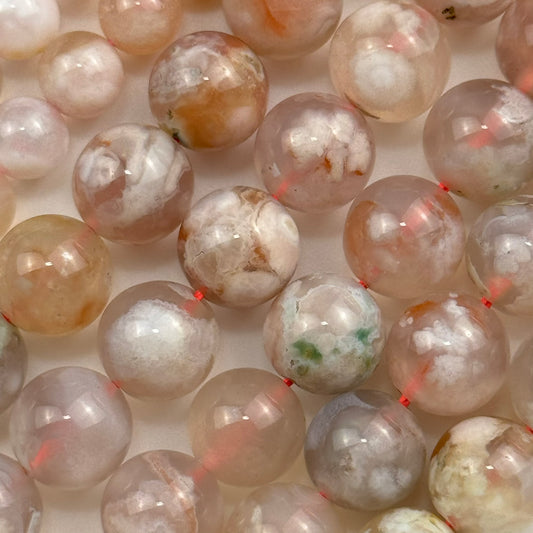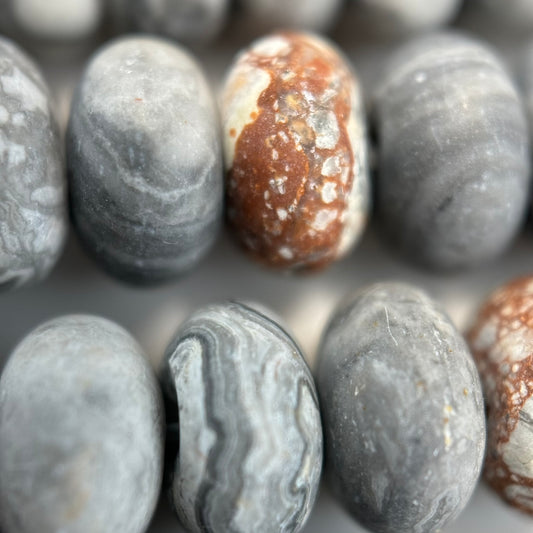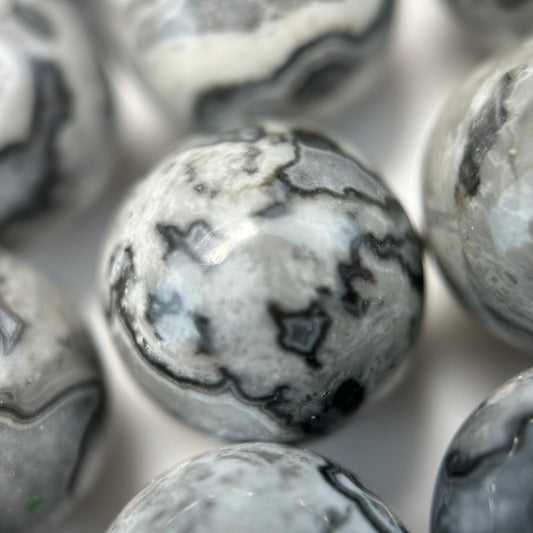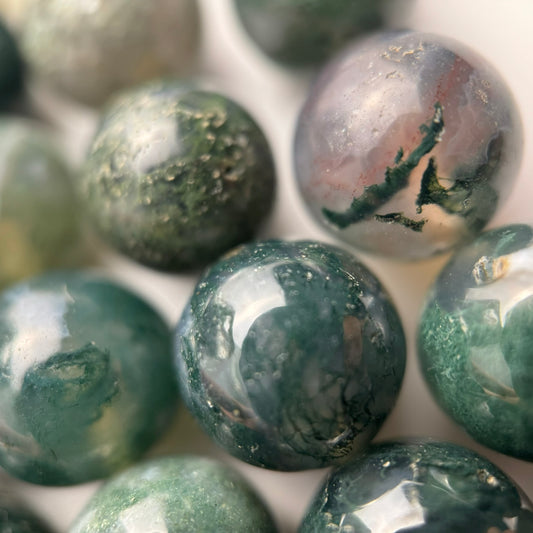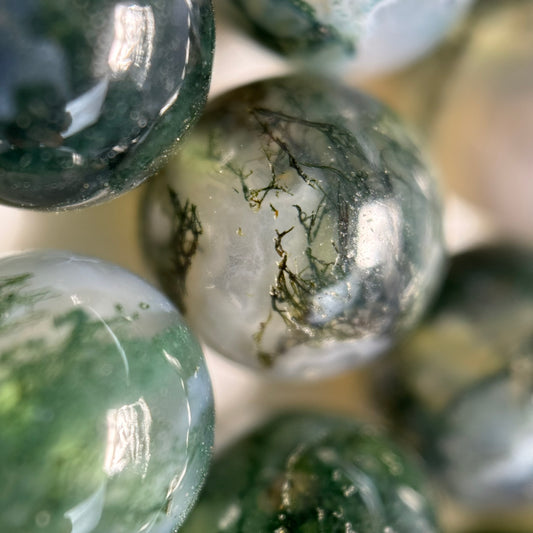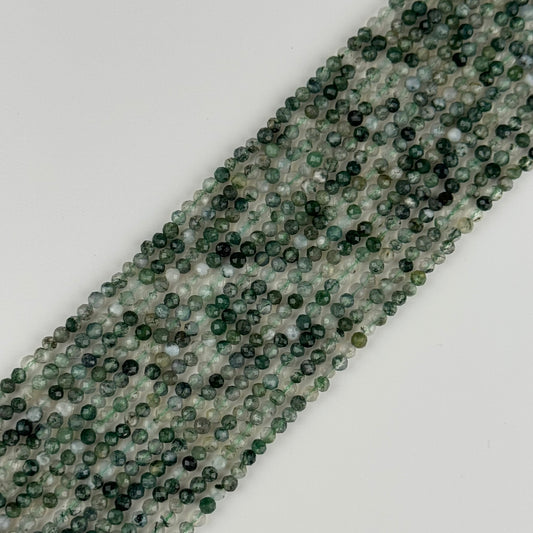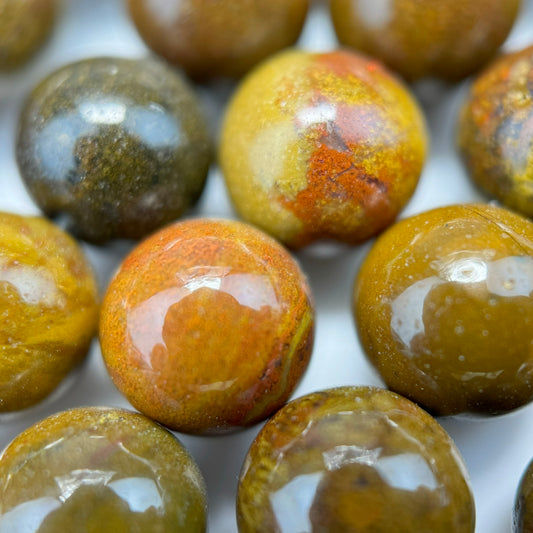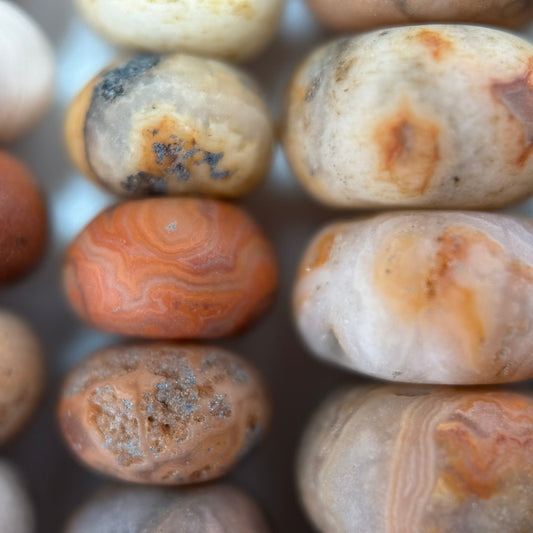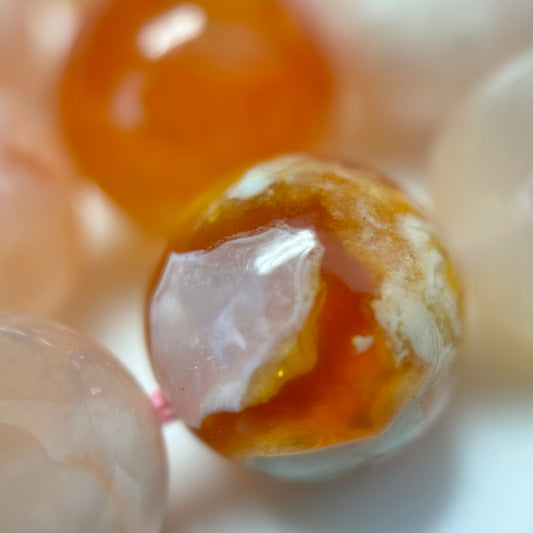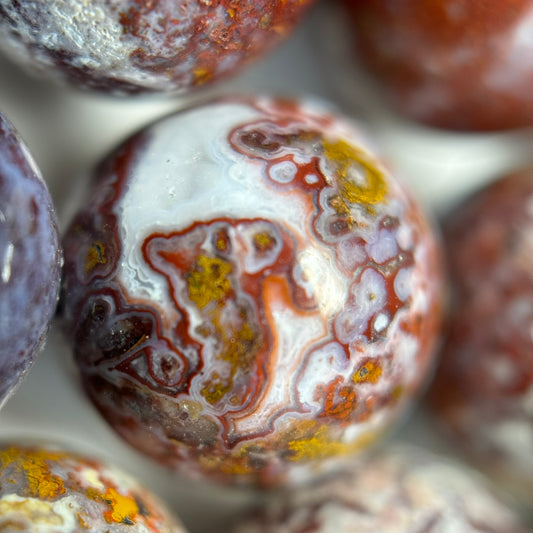Agate Beads Collection: Tree Moss, Blue Lace, Fire, Red, Black, Crazy Lace, Botswana, Dendritic, Green Agate Crystals & More
Agate
Agate is a variety of chalcedony, which itself is a microcrystalline form of quartz composed primarily of silicon dioxide (SiO₂). Its formation occurs within volcanic and metamorphic rocks through the deposition of silica from groundwater in cavities, creating its signature concentric banding. These bands often appear in alternating translucent and opaque layers, showcasing different colours due to varying trace mineral inclusions such as iron, manganese, and chromium.
Scientifically, agate belongs to the trigonal crystal system with a hardness of 6.5 to 7 on the Mohs scale, making it suitable for jewelry and ornamental carvings. Its dense structure and fine-grained composition result in high durability and polishability. Agate's specific gravity ranges between 2.58 to 2.64, and it generally lacks cleavage, breaking with a conchoidal fracture characteristic of quartz minerals.
Throughout history, agate has been used for utilitarian and decorative purposes, from ancient seals and amulets to modern beads and cabochons. Its varied colours, including red, brown, white, grey, blue, and green, occur naturally or can be enhanced through dyeing processes. Due to its intricate patterns and stable physical properties, agate remains a significant material in both geology for rock identification and in gemology for artistic and metaphysical applications.
Agate in Jewelry Making
Agate has been prized in jewelry making for thousands of years due to its durability, hardness, and striking natural patterns. Its hardness of 6.5 to 7 on the Mohs scale allows it to withstand daily wear without significant scratching or damage, making it ideal for crafting into beads, cabochons, pendants, and carved intaglios. Ancient cultures, including the Egyptians and Greeks, utilized agate in amulets and seals, believing it to carry protective and stabilizing properties.
In modern jewelry making, agate is frequently used to create statement pieces due to its vivid colour bands and translucency. Designers often prefer agate for its availability in large sizes and diverse colours, which include natural earthy tones as well as vibrant dyed varieties. The stone's ability to take a high polish enhances its visual appeal, making it a popular choice for bohemian-inspired jewelry, men's bracelets, malas, and contemporary minimalist designs alike.
Gem cutters work agate into calibrated beads, donut pendants, slabs, and carved forms, ensuring versatility for jewelry artisans. Its banded structure and varying opacity levels allow for creative integration into mixed gemstone designs, where it pairs harmoniously with metals such as sterling silver, gold-filled components, or copper. Overall, agate's combination of scientific durability and aesthetic beauty solidifies its essential role in both traditional and contemporary jewelry making.
Agate Beads and Jewelry
Agate beads are among the most widely used semi-precious beads in jewelry making due to their hardness, affordability, and unique natural patterns. They are typically cut from large agate nodules or geodes and shaped into round, faceted, or freeform beads. The fine microcrystalline structure of agate allows it to be drilled cleanly without significant fracturing, making it ideal for bead production in various sizes ranging from tiny seed beads to large statement rounds.
In jewelry, agate beads are incorporated into necklaces, bracelets, earrings, and malas. Their natural earthy tones—such as browns, greys, whites, and reds—provide organic aesthetics, while dyed agate beads in vibrant blues, pinks, or greens allow for striking contemporary designs. The concentric banding visible in many agate beads adds visual texture and dimension to jewelry pieces, enhancing their appeal both as standalone designs or in combination with metals and other gemstones like jasper, onyx, or quartz.
Agate jewelry is valued not only for its beauty but also for its symbolic and metaphysical properties, believed to promote grounding, balance, and emotional stability. Whether carved into cabochon rings, wrapped as pendants, or strung into mala prayer beads, agate remains an essential material in the gem and jewelry trade. Its combination of scientific strength and artistic versatility ensures it continues to inspire jewelers and collectors worldwide.
Moss Agate
Scientific Insight: Moss Agate is technically a form of chalcedony, a microcrystalline variety of quartz. Its green, moss-like inclusions are typically composed of minerals such as chlorite or hornblende, which form through the infiltration of mineral-rich water into silica gel cavities. Unlike banded agates, Moss Agate's inclusions are not organized in layers but are instead dendritic, meaning they branch like trees or moss. The stone's formation is a result of slow crystallization in volcanic rocks, where trace elements and mineral impurities create the unique internal landscapes seen in each specimen.
Moss Agate is a beautiful, translucent gemstone known for its moss-like inclusions that resemble natural landscapes. Unlike traditional agates, this stone doesn't have banding but features intricate green mineral patterns set in a clear to milky base. These unique formations make each piece one-of-a-kind, highly valued in both jewelry making and crystal healing communities. Moss Agate is often associated with grounding energy, emotional balance, and connection to nature.
At Reza Gem Collection, our Moss Agate beads are carefully selected for their natural beauty and clarity. Whether you're designing a custom bracelet, necklace, or using the stone for its metaphysical properties, Moss Agate is a versatile and calming gemstone. Handpicked by expert gemologist Reza Piroznia, each strand showcases the natural charm and energy this stone is known for, making it a favorite among artisans and collectors alike.
Moss Agate Gemstone Meaning
Scientific Insight: The green coloration in Moss Agate is due to the presence of trace elements, especially iron and manganese, within the silica matrix. These elements oxidize and crystallize in branching patterns, creating the mossy appearance. The lack of banding distinguishes Moss Agate from other agates, and its formation is closely tied to the geochemical environment of volcanic host rocks. The stone's microstructure can be studied under magnification, revealing the intricate interplay between silica and mineral inclusions that define its appearance.
Moss Agate is often associated with new beginnings, growth, and a deep connection to nature. Its green, moss-like inclusions symbolize renewal and abundance, making it a popular stone for those seeking balance and stability in life. Traditionally, Moss Agate has been considered a stone of prosperity and is believed to attract wealth and improve self-esteem.
Emotionally, Moss Agate is said to promote tranquility, patience, and emotional healing. Many people use it to reduce stress and bring a sense of calm during times of emotional imbalance. In spiritual practices, it is thought to support the heart chakra, encouraging compassion and a grounded, nurturing energy that resonates with the natural world.
Tree Agate
Scientific Insight: Tree Agate is a dendritic variety of chalcedony, where the green, tree-like inclusions are formed by manganese and iron oxides. These inclusions develop as mineral-rich solutions percolate through the silica gel, depositing minerals in branching, plant-like patterns. The base chalcedony is typically white or colorless, providing a stark contrast to the green inclusions. Tree Agate is found in regions with significant volcanic activity, where the right combination of silica and trace minerals is present for its unique formation.
Tree Agate is a calming and nurturing stone known for its green, tree-like inclusions that resemble forest foliage. It symbolizes inner peace, abundance, and a strong connection to nature. Often associated with personal growth and emotional healing, Tree Agate is believed to encourage patience, stability, and a grounded outlook. Its energy is gentle yet stabilizing, making it a favorite among those seeking balance and harmony in their lives.
This stone is connected to the heart chakra and is thought to promote compassion, emotional strength, and a sense of inner security. Tree Agate is commonly used in meditation and healing practices to release stress and encourage a peaceful mindset. Its natural patterns and earthy tones also make it a beautiful and meaningful addition to jewelry or decorative collections.
Blue Lace Agate
Scientific Insight: Blue Lace Agate is characterized by its delicate blue and white banding, which results from rhythmic crystallization of silica with varying trace elements, primarily aluminum and iron. The blue color is due to the presence of trace amounts of copper or other transition metals. The bands form as layers of chalcedony are deposited in cavities within volcanic rocks, with subtle changes in the geochemical environment leading to the formation of the lace-like patterns. This process can take millions of years, resulting in the stone's signature appearance.
Blue Lace Agate is a gentle, soothing gemstone known for its soft blue color and delicate white banding. Often associated with calm communication and emotional clarity, this stone is widely used in crystal healing for reducing anxiety and encouraging peaceful expression. Its serene appearance makes it a favorite in both spiritual practices and artisan jewelry designs.
This variety of agate is believed to carry nurturing energy, making it ideal for those seeking inner peace and emotional balance. Blue Lace Agate is also appreciated for its subtle elegance, often cut into beads or cabochons for necklaces, bracelets, and meditative talismans. Its natural patterns and calming hues reflect a sense of stillness and clarity that resonates with many users worldwide.
Fancy Red Agate
Scientific Insight: Fancy Red Agate's vibrant red and orange hues are primarily due to the presence of iron oxides within the silica structure. The coloration and banding patterns are formed as iron-rich solutions infiltrate the silica gel, oxidizing and depositing iron minerals in layers. The process of agate formation involves repeated episodes of mineral deposition, often in volcanic or sedimentary environments, which create the complex and colorful banding seen in red agates. The durability and vivid coloration make this variety especially prized in lapidary arts.
Fancy Red Agate is a vibrant variety of agate known for its deep red, orange, and earthy tones. It is often associated with vitality, strength, and emotional protection. Historically, red agate has been used as a grounding stone, believed to stabilize the aura and promote physical energy. Its rich, warm colors reflect inner fire and resilience, making it a favorite for those seeking motivation and confidence.
This striking stone is also linked to the root chakra, encouraging a sense of security, stability, and balance. Fancy Red Agate is used in meditation and healing practices to dispel fear, calm anger, and enhance inner peace. Its natural patterns and bold color variations make it both spiritually meaningful and visually captivating in jewelry and decorative pieces.
Black Agate
Scientific Insight: Black Agate is a variety of chalcedony that owes its deep coloration to the presence of organic carbon or iron and manganese oxides within the silica matrix. The black color can also result from natural irradiation or the presence of microscopic inclusions of other minerals. Black Agate often forms in volcanic rocks, where silica-rich fluids fill cavities and gradually crystallize. The subtle banding sometimes seen in black agate is a result of slight variations in mineral content during the stone's growth.
Black Agate is a powerful grounding stone known for its protective energy and calming influence. With its deep black color and subtle banding, this stone is often used to promote emotional stability, inner strength, and clarity of thought. It is believed to absorb negative energy and transform it into positive vibrations, making it a popular choice for those seeking balance and resilience during challenging times.
Associated with the root chakra, Black Agate supports feelings of safety and security while enhancing concentration and focus. In spiritual practices, it is used for meditation, grounding rituals, and energy cleansing. Its elegant appearance and stabilizing properties make Black Agate a versatile gemstone in both metaphysical work and jewelry design.
Crazy Lace Agate
Scientific Insight: Crazy Lace Agate is renowned for its intricate, swirling bands of multiple colors, which are the result of complex geological processes. The stone forms in cavities within volcanic rocks, where silica-rich fluids deposit successive layers of chalcedony interspersed with iron, aluminum, and other trace elements. The dynamic patterns are created by changes in the chemical environment, temperature, and pressure during formation. This variety is primarily found in northern Mexico and is prized for its unique, lace-like banding and vibrant palette.
Crazy Lace Agate is a colorful and vibrant gemstone known for its swirling patterns and bold bands of red, yellow, white, and brown. Often referred to as the "Laughter Stone" or "Happy Lace," it is believed to bring joy, optimism, and mental clarity. This unique agate variety is associated with uplifting energy and is commonly used to combat emotional exhaustion and promote a positive outlook.
Traditionally linked to the solar plexus chakra, Crazy Lace Agate supports emotional balance, self-confidence, and personal power. Its dynamic patterns and cheerful energy make it popular for jewelry, especially in bracelets and pendants designed to inspire creativity and light-heartedness. Whether used in spiritual practices or simply admired for its natural beauty, Crazy Lace Agate is a stone that brings movement, color, and joy into everyday life.
Botswana Agate
Scientific Insight: Botswana Agate is a banded chalcedony that forms in the volcanic rocks of Botswana, Africa. Its fine, parallel bands are created by rhythmic precipitation of silica from groundwater in volcanic cavities. The subtle colors—gray, pink, and brown—are due to trace elements such as iron, manganese, and titanium. Botswana Agate is notable for its high degree of translucency and the precision of its banding, which can be studied to understand the environmental conditions present during its formation.
Botswana Agate is a striking variety of banded agate known for its fine, layered patterns in soft shades of gray, pink, and brown. Sourced primarily from Botswana in southern Africa, this stone is highly regarded for its soothing energy and subtle beauty. It is believed to help with emotional healing, relieve stress, and support a calm, centered mindset—making it a favorite among those seeking inner peace and clarity.
Often associated with the crown and root chakras, Botswana Agate is thought to encourage mindfulness, stability, and a deeper connection to one's higher self. It's commonly used in meditation and spiritual practices to support transformation and growth. With its elegant natural patterns, Botswana Agate is also a popular choice in fine jewelry, offering both aesthetic appeal and grounding metaphysical properties.
Dendritic Agate
Scientific Insight: Dendritic Agate is distinguished by its tree- or fern-like inclusions, which are formed by manganese and iron oxides that crystallize within the chalcedony. These dendrites are not true fossils but are mineral growths that occur as mineral-rich water seeps into the stone's microcracks. The base agate is typically colorless or milky, providing a contrasting background for the dark dendritic patterns. Dendritic Agate is found in both volcanic and sedimentary environments, where slow mineral deposition allows for the development of its characteristic inclusions.
Dendritic Agate is a captivating gemstone known for its delicate, tree-like inclusions that resemble branches or ferns. These natural patterns are formed by traces of iron or manganese, creating a unique landscape within each stone. Often called the "Stone of Plenitude," Dendritic Agate is associated with abundance, personal growth, and connection to the earth. It is cherished for its grounding energy and its ability to bring clarity and stability during times of change.
This gemstone is commonly linked to the root and crown chakras, helping to balance physical energy while encouraging spiritual awareness. Dendritic Agate is used in meditation to foster patience and inner peace, making it a popular choice for emotional healing. Its organic patterns and soft, neutral tones also make it a stunning option for jewelry and artistic designs.
Green Agate
Scientific Insight: Green Agate is a variety of chalcedony that gets its color from trace amounts of chromium, nickel, or iron within the silica structure. The green coloration can occur naturally or be enhanced through dyeing. Natural green agate forms in volcanic rocks, where mineral-rich fluids deposit layers of silica and trace elements over time. The stone's durability and vibrant color make it a popular choice for both decorative and scientific study.
Sakura Green Agate
Scientific Insight: Sakura Green Agate's floral-like patterns are the result of unique mineral inclusions and growth conditions during the stone's formation. The soft green color is typically due to chromium or iron, while the cherry blossom-like inclusions are formed by localized concentrations of other minerals. These patterns are preserved as the silica gel slowly crystallizes in volcanic cavities, capturing the intricate interplay of mineral deposition and environmental factors.
Sakura Green Agate is a beautiful and unique variety of green agate featuring soft floral-like patterns that resemble cherry blossoms. This gemstone is often associated with new beginnings, emotional renewal, and harmony with nature. Its gentle green tones combined with delicate inclusions create a calming energy, ideal for those seeking emotional balance and heart-centered healing.
This variety is frequently used in spiritual practices to support the heart chakra and foster compassion, patience, and personal growth. The elegant patterns and serene color of Sakura Green Agate make it a popular choice for jewelry makers and collectors looking for stones that are both meaningful and visually distinctive.
Dyed Green Agate
Scientific Insight: Dyed Green Agate is produced by soaking natural agate in chemical solutions that penetrate the stone's porous structure, enhancing or changing its color. While the base agate forms through natural geological processes, the vivid green hue is the result of human intervention. The dyeing process does not alter the fundamental microcrystalline structure of the chalcedony, but it does provide a wider range of color options for decorative and jewelry purposes. Scientists can distinguish dyed from natural agate using spectroscopic analysis and microscopic examination.
Dyed Green Agate is a vibrant, color-enhanced version of natural agate that offers bold and uniform shades of green. While not naturally occurring in such vivid hues, dyed green agate retains the stabilizing and grounding properties of natural agate. It is often used to bring focus, strength, and a sense of renewal to one's daily life, making it a favorite in energy work and decorative designs.
This variety is popular in jewelry making due to its bright, eye-catching color and affordability. Dyed Green Agate beads and cabochons are commonly used in necklaces, bracelets, and earrings where a strong visual impact is desired. Despite the dyeing process, the stone still carries the symbolic meaning of growth, stability, and protection.
Agate Crystal: Composition and Formation
Scientific Insight: The formation of agate involves the slow precipitation of silica from groundwater in volcanic or sedimentary environments. Over time, layers of chalcedony are deposited in concentric bands, often around a central cavity or nucleus. The presence of trace elements and varying conditions during deposition result in the diverse colors and patterns seen in agate. Advanced analytical techniques, such as scanning electron microscopy and X-ray diffraction, are used to study agate's microstructure and reveal details about its growth history and the environmental conditions of its formation.
Agate is a variety of chalcedony, which is a microcrystalline form of quartz composed primarily of silicon dioxide (SiO₂). Unlike large quartz crystals that have visible crystal faces, agate's crystals are microscopic, creating a dense, fine-grained texture. This unique structure results in the characteristic banding and patterns found in agate, caused by successive layers of mineral deposits over time.
Formed mainly in volcanic and metamorphic rocks, agate develops when silica-rich water fills cavities and voids, slowly depositing layers of chalcedony. Variations in trace elements and impurities during this process produce the wide range of colors and intricate banding patterns typical of agate. Its durable composition and striking appearance have made agate a popular material for both ornamental and metaphysical purposes.
Fire Agate
Fire Agate is a rare and captivating variety of chalcedony characterized by its iridescent, fiery colors that shimmer in hues of red, orange, yellow, and green. These vibrant colors are caused by thin layers of iron oxide within the stone, which create a phenomenon known as "iridescence" or "play-of-color." This unique optical effect gives Fire Agate its distinctive and mesmerizing appearance.
Formed primarily in volcanic rocks, Fire Agate develops when silica-rich solutions deposit layers of chalcedony over iron deposits, resulting in the stone's characteristic iridescent layers. Its hardness and durability make it suitable for jewelry and ornamental use. Beyond its beauty, Fire Agate is also valued in metaphysical circles for its reputed ability to boost creativity, passion, and vitality.
Scientific Insight: The iridescence in Fire Agate is produced by the interference of light as it passes through extremely thin, alternating layers of silica and iron oxide (limonite) within the chalcedony. These micro-layers act like a diffraction grating, splitting and reflecting light to create the stone's signature play-of-color. The formation of Fire Agate requires a unique combination of volcanic activity, mineral-rich hydrothermal fluids, and slow cooling, which allows for the sequential deposition of these thin layers. This process can take millions of years, and the resulting structure is so intricate that each Fire Agate specimen is truly one-of-a-kind. Analytical techniques such as scanning electron microscopy reveal the nanoscale layering responsible for the optical effects seen in high-quality Fire Agate.
Crystal Shop Near Me
If you are searching for a trusted crystal shop near me , Reza Gem Collection is an excellent choice. Known for its wide selection of high-quality natural gemstones, including beautiful agate beads, Reza Gem Collection offers expert guidance and exceptional customer service. Whether you are a jewelry maker, collector, or simply love crystals, this shop provides a reliable and convenient option to find unique stones that meet your needs.
Frequently Asked Questions
What is agate?
Agate is a variety of chalcedony, which is a microcrystalline form of quartz composed primarily of silicon dioxide (SiO₂). It forms within volcanic and metamorphic rocks through the deposition of silica from groundwater in cavities, creating its signature concentric banding. These bands often appear in alternating translucent and opaque layers, showcasing different colors due to varying trace mineral inclusions such as iron, manganese, and chromium.
How hard is agate on the Mohs scale?
Agate has a hardness of 6.5 to 7 on the Mohs scale, making it suitable for jewelry and ornamental carvings. This hardness allows it to withstand daily wear without significant scratching or damage, making it ideal for crafting into beads, cabochons, pendants, and carved intaglios.
What colors does agate come in?
Agate comes in a wide variety of colors including red, brown, white, grey, blue, and green. These colors occur naturally or can be enhanced through dyeing processes. The specific colors depend on the trace elements present during formation, such as iron, manganese, and chromium.
What is the difference between agate and chalcedony?
Agate is a specific variety of chalcedony that features distinctive banding patterns. While all agate is chalcedony, not all chalcedony is agate. Agate is characterized by its concentric banding, while other forms of chalcedony may be solid-colored or have different patterns.
How is agate formed?
Agate forms when silica-rich water fills cavities and voids in volcanic or metamorphic rocks, slowly depositing layers of chalcedony. The formation involves the slow precipitation of silica from groundwater in volcanic or sedimentary environments. Over time, layers of chalcedony are deposited in concentric bands, often around a central cavity or nucleus.
What is Moss Agate?
Moss Agate is a form of chalcedony known for its moss-like inclusions that resemble natural landscapes. Unlike traditional agates, this stone doesn't have banding but features intricate green mineral patterns set in a clear to milky base. The green, moss-like inclusions are typically composed of minerals such as chlorite or hornblende.
What is Blue Lace Agate?
Blue Lace Agate is characterized by its delicate blue and white banding, which results from rhythmic crystallization of silica with varying trace elements, primarily aluminum and iron. The blue color is due to the presence of trace amounts of copper or other transition metals. It's known for its gentle, soothing energy and is often associated with calm communication and emotional clarity.
What is Fire Agate?
Fire Agate is a rare variety of chalcedony characterized by its iridescent, fiery colors that shimmer in hues of red, orange, yellow, and green. These vibrant colors are caused by thin layers of iron oxide within the stone, which create a phenomenon known as "iridescence" or "play-of-color." Each Fire Agate specimen is truly one-of-a-kind due to its intricate formation process.
What is Crazy Lace Agate?
Crazy Lace Agate is renowned for its intricate, swirling bands of multiple colors, which are the result of complex geological processes. Often referred to as the "Laughter Stone" or "Happy Lace," it is believed to bring joy, optimism, and mental clarity. This variety is primarily found in northern Mexico and is prized for its unique, lace-like banding and vibrant palette.
What is Botswana Agate?
Botswana Agate is a banded chalcedony that forms in the volcanic rocks of Botswana, Africa. It's known for its fine, layered patterns in soft shades of gray, pink, and brown. This stone is highly regarded for its soothing energy and subtle beauty, often used for emotional healing and stress relief.
What is Dendritic Agate?
Dendritic Agate is distinguished by its tree- or fern-like inclusions, which are formed by manganese and iron oxides that crystallize within the chalcedony. Often called the "Stone of Plenitude," it is associated with abundance, personal growth, and connection to the earth. These dendrites are not true fossils but are mineral growths that occur as mineral-rich water seeps into the stone's microcracks.
What is the difference between natural and dyed green agate?
Natural green agate gets its color from trace amounts of chromium, nickel, or iron within the silica structure. Dyed green agate is produced by soaking natural agate in chemical solutions that penetrate the stone's porous structure, enhancing or changing its color. While dyed agate retains the stabilizing properties of natural agate, scientists can distinguish between them using spectroscopic analysis and microscopic examination.
How is agate used in jewelry making?
Agate has been prized in jewelry making for thousands of years due to its durability, hardness, and striking natural patterns. It's commonly crafted into beads, cabochons, pendants, and carved intaglios. Agate beads are among the most widely used semi-precious beads in jewelry making due to their hardness, affordability, and unique natural patterns.
What are the metaphysical properties of agate?
Agate is valued for its symbolic and metaphysical properties, believed to promote grounding, balance, and emotional stability. Different varieties have specific associations: Moss Agate is linked to growth and nature connection, Blue Lace Agate to calm communication, and Crazy Lace Agate to joy and optimism. Agate is commonly associated with the root chakra and is used for meditation and energy work.
How can you identify genuine agate?
Genuine agate can be identified by its characteristic banding patterns, hardness (6.5-7 on Mohs scale), and specific gravity (2.58-2.64). It lacks cleavage and breaks with a conchoidal fracture characteristic of quartz minerals. The presence of natural banding and the stone's translucency are key indicators of authentic agate.
Where is agate found?
Agate is found worldwide in regions with volcanic activity. Notable locations include Brazil, Uruguay, Mexico, Madagascar, India, and the United States. Specific varieties have distinct origins: Botswana Agate comes from Botswana, Africa, while Crazy Lace Agate is primarily found in northern Mexico. The formation requires volcanic rocks with cavities where silica-rich fluids can deposit.
How should agate be cared for?
Agate is relatively durable but should be protected from harsh chemicals and extreme temperature changes. Clean with mild soap and warm water, avoiding ultrasonic cleaners and steam cleaning. Store separately from harder gemstones to prevent scratching, and avoid prolonged exposure to direct sunlight which can fade dyed varieties.
What is the value of agate?
Agate's value depends on factors such as rarity, color intensity, pattern quality, and size. Rare varieties like Fire Agate command higher prices, while common banded agates are more affordable. The quality of the banding, translucency, and absence of fractures also significantly affect value. Dyed agates are generally less valuable than natural-colored specimens.
Can agate be used for meditation?
Yes, agate is widely used in meditation and spiritual practices. Different varieties serve different purposes: Moss Agate for grounding and nature connection, Blue Lace Agate for calm communication, Botswana Agate for emotional healing, and Dendritic Agate for abundance and growth. Agate is commonly linked to the root chakra and helps balance physical energy while encouraging spiritual awareness.
What makes each agate specimen unique?
Each agate specimen is unique due to the complex geological processes involved in its formation. Variations in trace elements, temperature, pressure, and chemical environment during formation create distinct patterns and colors. The banding patterns, inclusions, and color variations are never exactly the same, making each piece one-of-a-kind. This uniqueness is especially evident in varieties like Fire Agate and Crazy Lace Agate.
How has agate been used throughout history?
Throughout history, agate has been used for utilitarian and decorative purposes, from ancient seals and amulets to modern beads and cabochons. Ancient cultures, including the Egyptians and Greeks, utilized agate in amulets and seals, believing it to carry protective and stabilizing properties. Its intricate patterns and stable physical properties have made it a significant material in both geology for rock identification and in gemology for artistic and metaphysical applications.

